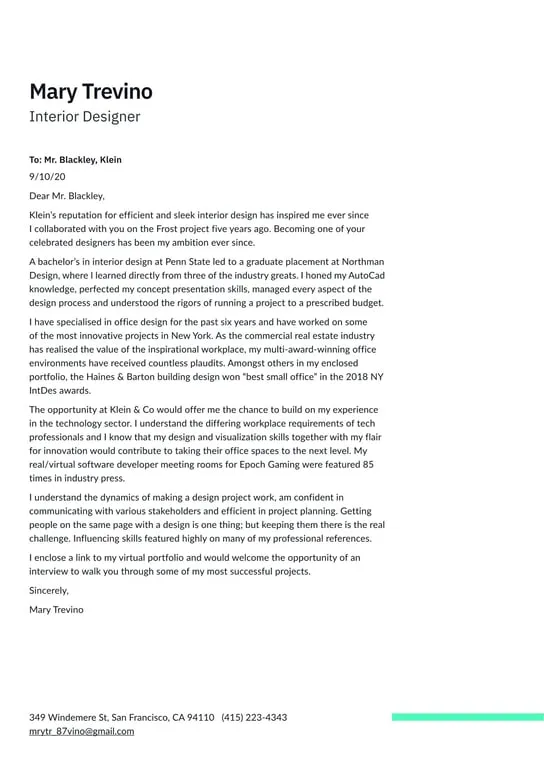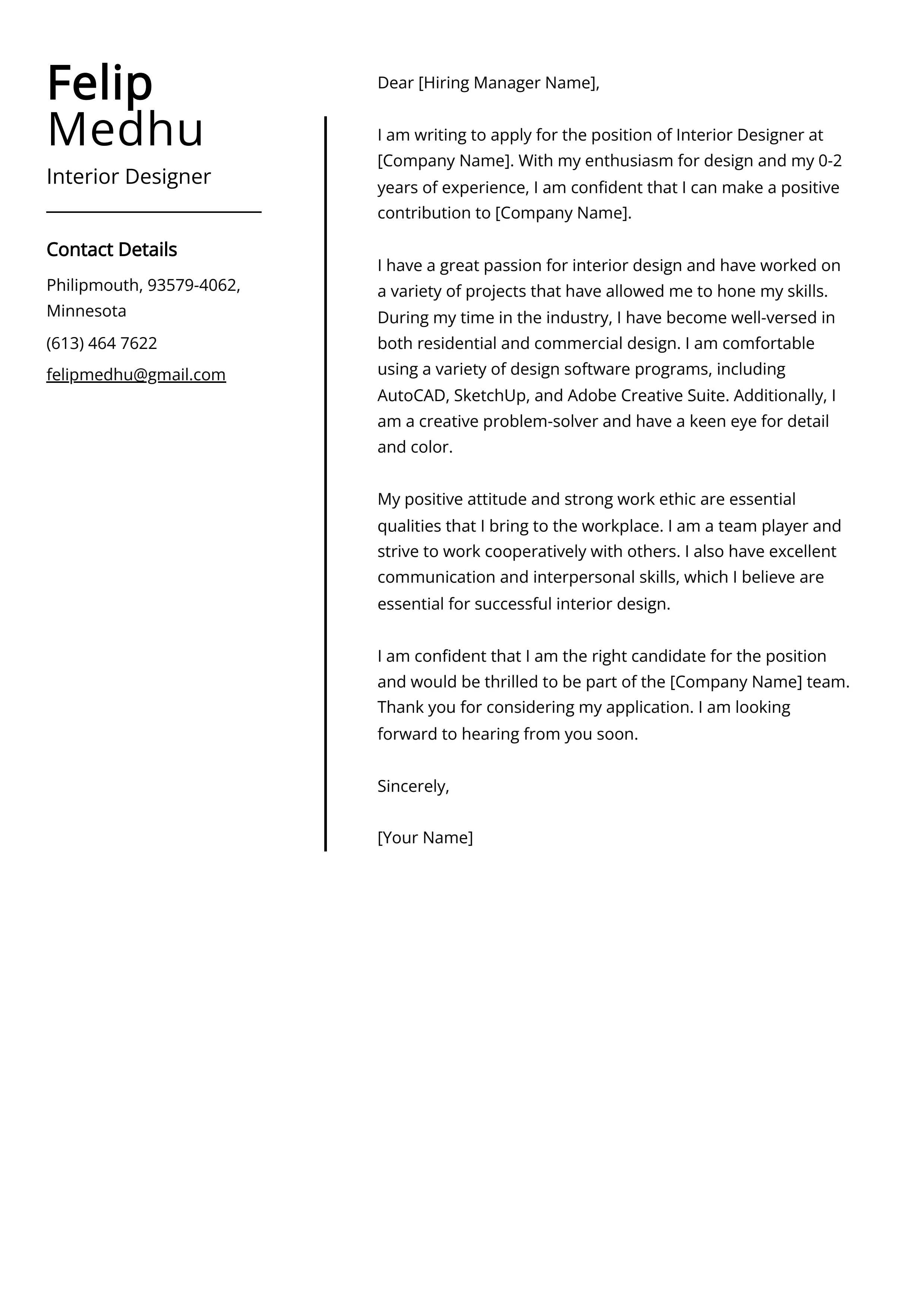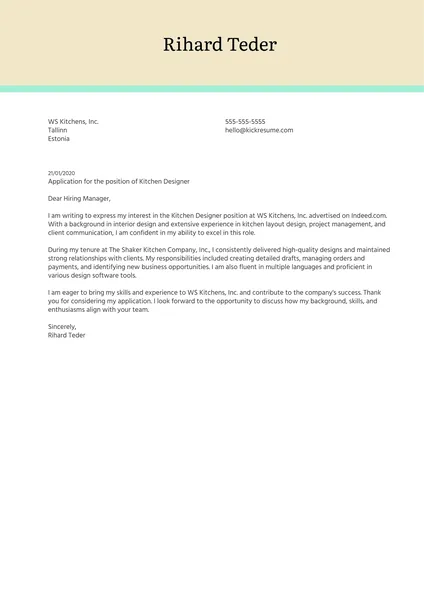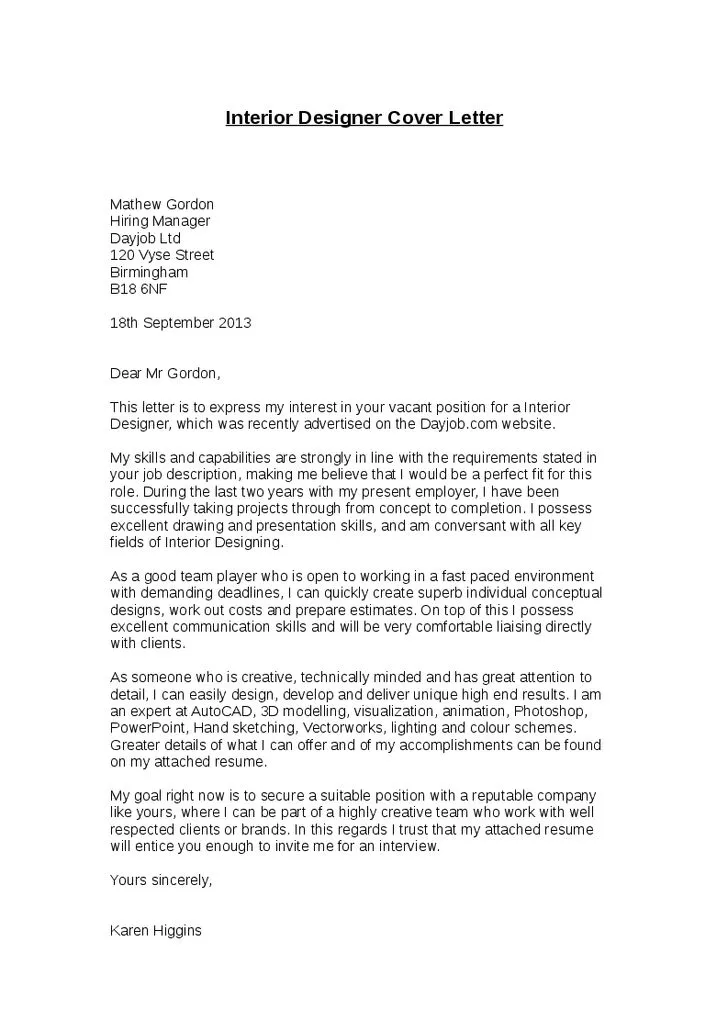What is an Interior Design Cover Letter?
An interior design cover letter is a crucial document that accompanies your resume when applying for interior design positions. It serves as your introduction to a potential employer, allowing you to showcase your personality, passion, and suitability for the role beyond the basic information listed in your resume. It’s your chance to tell a story, highlight your key accomplishments, and demonstrate why you’re the perfect fit for the company and the specific job opening. A well-crafted cover letter can significantly increase your chances of getting an interview and landing your dream job in the competitive field of interior design. In the current job market, competition is fierce, so every element of your application must be polished and compelling to grab the attention of hiring managers.
Why You Need a Cover Letter
While a resume provides a summary of your experience and qualifications, a cover letter offers a platform to elaborate on those points and connect with the hiring manager on a personal level. It’s an opportunity to articulate your career goals, explain why you’re interested in the specific company, and demonstrate your understanding of the interior design industry. It allows you to address any potential gaps in your resume, such as career changes or periods of unemployment, by providing context and demonstrating your proactive approach. Many hiring managers consider cover letters as a testament to your communication skills, attention to detail, and your genuine interest in the position. Therefore, it is critical to create a compelling cover letter.
Key Elements of a Strong Interior Design Cover Letter

A compelling interior design cover letter contains specific and compelling elements. Begin with a professional salutation, addressing the hiring manager by name if possible. The opening paragraph should capture their attention, clearly stating the position you’re applying for and expressing your enthusiasm. The body of the letter should highlight your relevant skills and experience, providing specific examples of your accomplishments and quantifying your contributions whenever possible. Demonstrate your knowledge of the company and their work, showcasing how your skills align with their values and projects. The closing paragraph should reiterate your interest, express your availability for an interview, and include a call to action. Proofread carefully to eliminate any grammatical errors, typos, or formatting inconsistencies.
Highlighting Your Skills
When crafting your cover letter, emphasize the skills that are most relevant to the interior design position you’re applying for. This includes both technical and soft skills. Technical skills to highlight include proficiency in design software like AutoCAD, Revit, SketchUp, and Adobe Creative Suite. Showcase your knowledge of space planning, materials selection, construction documentation, and project management. In terms of soft skills, highlight your creativity, communication skills, problem-solving abilities, and your ability to work effectively in a team. Provide specific examples of how you have utilized these skills to achieve successful outcomes in past projects. Tailor the skills to the job description, aligning them with the company’s requirements to demonstrate your suitability for the role.
Showcasing Your Experience
The experience section of your interior design cover letter is your opportunity to showcase your relevant work history and accomplishments. Instead of simply listing your job duties, focus on the impact you made in each role. Describe specific projects you’ve worked on, detailing your responsibilities and contributions. Use the STAR method (Situation, Task, Action, Result) to structure your examples, providing context, explaining your actions, and highlighting the positive outcomes you achieved. Quantify your achievements whenever possible, using numbers or percentages to demonstrate the value you brought to your previous employers. For instance, mention how you managed projects within budget, increased client satisfaction, or improved design efficiency. Always align your experience with the requirements of the job you’re applying for.
Cover Letter Example for Entry-Level Interior Designer

For an entry-level position, your cover letter should focus on your education, any internships or volunteer work, and your passion for interior design. Start by expressing your strong interest in the role and the company. Highlight relevant coursework, projects completed during your education, and any design competitions or awards you’ve received. If you have any internships, describe your responsibilities and the skills you developed. Even if you lack professional experience, emphasize your eagerness to learn, your design aesthetic, and your enthusiasm for the field. Tailor your letter to the specific job description, aligning your skills and experiences to demonstrate your potential as an entry-level designer. Make sure to mention your knowledge of design software.
Cover Letter Example for Experienced Interior Designer
For experienced interior designers, your cover letter should showcase your proven track record and accomplishments. Start by highlighting your years of experience and the types of projects you’ve managed. Showcase your successful projects, focusing on the specific contributions you made, and the positive results you achieved. Quantify your achievements, providing statistics on project budgets, timelines, and client satisfaction. Highlight your leadership skills, your ability to manage teams, and your proficiency in design software. Tailor your letter to the specific job, focusing on how your experience aligns with the company’s requirements and the projects they undertake. Include any specializations or areas of expertise, such as sustainable design or commercial design, if they match the job description.
Tailoring Your Cover Letter for Each Application
One of the most important strategies is to tailor your cover letter for each job application. Never send a generic cover letter. Instead, carefully review the job description and identify the key requirements and qualifications. Research the company, understanding their values, their design style, and the projects they’ve worked on. Customize your cover letter to address the specific requirements, highlighting the skills and experiences that align with what the employer is looking for. This personalized approach demonstrates your genuine interest in the role and increases your chances of making a positive impression. It also shows your attention to detail, which is essential in interior design.
Proofreading and Editing Your Cover Letter

Before submitting your cover letter, carefully proofread and edit it for any errors. Typos, grammatical errors, and formatting inconsistencies can damage your credibility and undermine your application. Use a spell checker and grammar checker, but don’t rely on them completely. Read your cover letter aloud to catch any awkward phrasing or unclear sentences. Ask a friend, mentor, or career advisor to review your cover letter for feedback. Pay attention to the tone of your letter, ensuring it is professional, enthusiastic, and reflects your personality. Ensuring your cover letter is polished and error-free demonstrates your attention to detail, which is a critical attribute in interior design.
How to Stand Out from the Competition
To stand out in a competitive job market, consider the following tips. Include a portfolio link or attach a PDF of your best work. Highlight your unique design style and approach. Demonstrate your knowledge of current design trends and industry best practices. If you have any special certifications or awards, mention them in your cover letter. Show enthusiasm for the company and the specific position. Personalize your cover letter to the hiring manager, if possible. By following these guidelines, you’ll create a cover letter that impresses potential employers and increases your chances of landing an interview and a job in interior design.
